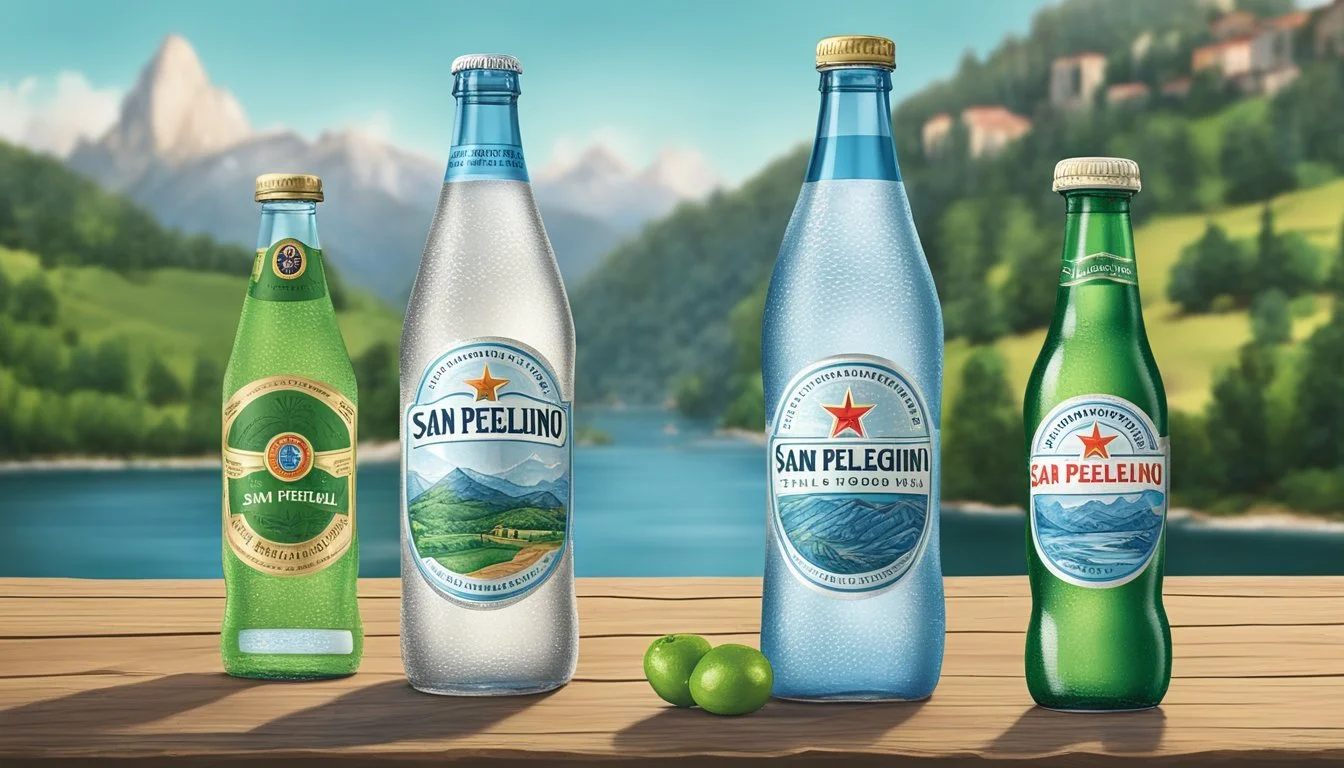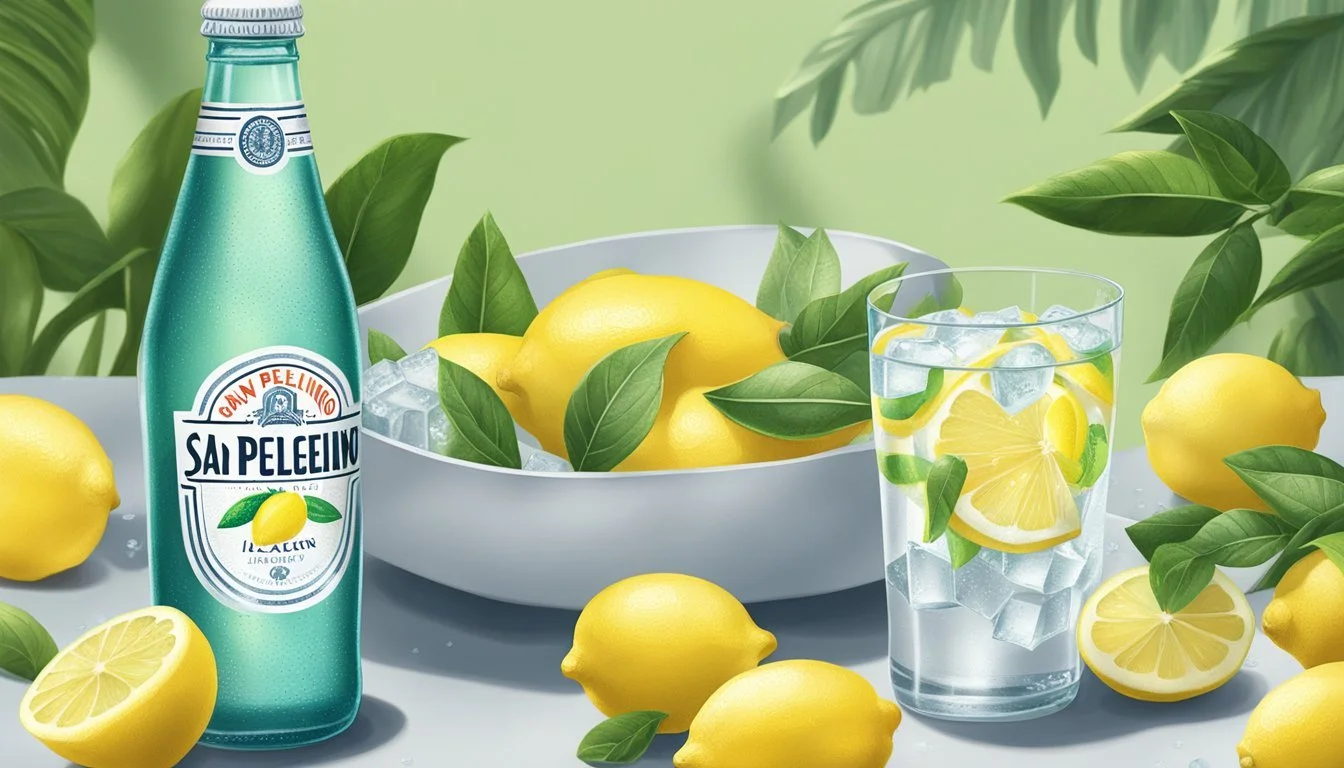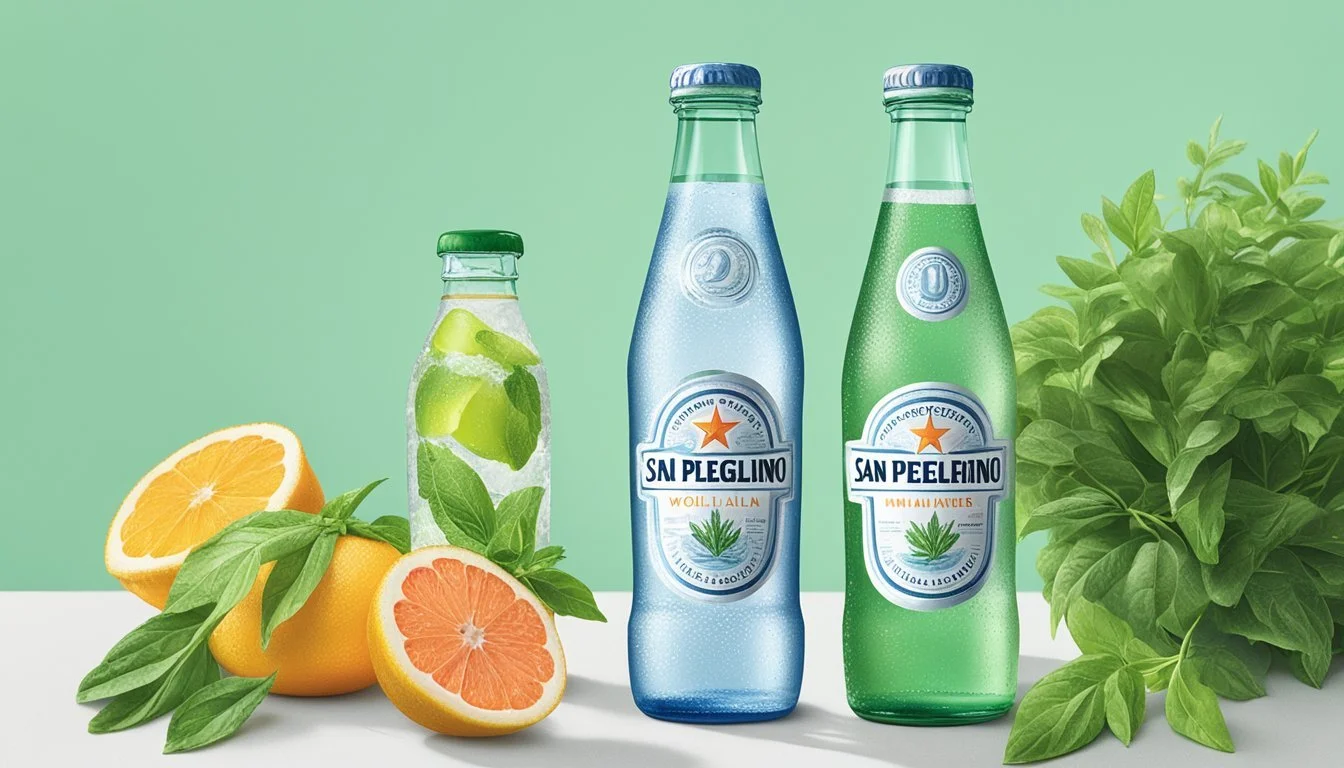San Pellegrino vs. Whole Foods Italian Still Mineral Water
Which Bottled Water is Better?
Choosing between San Pellegrino and Whole Foods Italian Still Mineral Water3 boils down to a few key factors such as taste, hydration, and health benefits. San Pellegrino, a renowned Italian mineral water brand, is celebrated for its crisp, sparkling quality and rich mineral content sourced from the Alpine Mountains. This type of water is often praised for aiding digestion, making it a favorite among those looking for a premium hydration experience.
Whole Foods Italian Still Mineral Water3, on the other hand, offers a smooth, still alternative that pairs well with a variety of dishes. Its subtle flavor and natural mineral richness provide a clean-tasting option, ideal for those who prefer non-sparkling water. Despite its understated profile, Whole Foods Italian Still Mineral Water3 holds its own, offering pure hydration with a touch of elegance.
Both options come from natural Italian sources, ensuring high quality and a mineral-rich composition. While San Pellegrino might appeal to those who enjoy a refreshing sparkle, Whole Foods Italian Still Mineral Water3 caters to individuals who prefer a quieter, still water. Each brings distinct advantages to the table, whether for everyday hydration or accompanying a fine meal.
Origins and History
San Pellegrino and Whole Foods Italian Still Mineral Water both boast rich heritages rooted in Italy, yet their paths to becoming popular bottled waters are quite distinct.
San Pellegrino: A Legacy of Italian Mineral Water
San Pellegrino, a name synonymous with fine dining, traces its origin back to 1899. This mineral water hails from the town of San Pellegrino Terme in the Lombardy region of Italy.
Founded by the Società Anonima delle Terme di San Pellegrino, the brand quickly became renowned for its mineral-rich water. Sourced from a natural spring, San Pellegrino water is celebrated for incorporating at least ten naturally occurring minerals, adding to its unique taste.
In the early 20th century, the brand's reputation grew internationally. Today, San Pellegrino mineral water is a staple in upscale restaurants and is often paired with gourmet meals, making it a symbol of refined Italian culinary tradition.
Whole Foods Italian Still Mineral Water: The Store Brand's Emergence
Whole Foods Market, an American multinational supermarket chain, entered the bottled water market with their Italian Still Mineral Water, sourced directly from Italy.
The water is marketed as being sourced from a pristine Italian spring, aligning with Whole Foods' commitment to quality and environmental sustainability. Though the water's exact historical roots are less documented compared to San Pellegrino, it has carved out a niche due to its affordability and accessibility in the global market.
Consumers who value both the Italian heritage and the convenience of a store brand can find an appealing option in Whole Foods Italian Still Mineral Water. The product is available in various sizes and packaged to meet sustainable and quality standards set by the retailer.
Source and Production
San Pellegrino and Whole Foods Italian Still Mineral Water differ primarily in their origin and bottling practices. Understanding the nuances of their sources and production methods can provide insight into their unique characteristics.
Natural Springs and Aqueducts
San Pellegrino originates from a natural spring in the Lombardy region of Italy, specifically from the Alpine slopes near the Dolomites. This region is known for its rich mineral content. The water flows through aquifers, absorbing essential minerals such as calcium, magnesium, and bicarbonate. This journey through geological layers imparts its distinct taste.
Whole Foods Italian Still Mineral Water is sourced from select springs across Italy, chosen for their purity and mineral diversity. These springs are typically located in remote, protected areas, ensuring minimal contamination. The water's mineral profile varies depending on the specific spring, offering a range of tastes and beneficial properties.
Bottling Process and Materials
San Pellegrino uses a meticulous bottling process to maintain the water's purity and quality. The spring water is transported via aqueducts to the bottling plant, where it undergoes minimal treatment to preserve its natural composition. San Pellegrino is predominantly bottled in glass bottles, which helps retain its mineral content and taste.
Whole Foods Italian Still Mineral Water is bottled using high standards to ensure safety and quality. The bottling facility is located close to the source to minimize transportation and preserve freshness. Whole Foods often uses a mix of glass and plastic materials for its bottles, catering to various consumer preferences and ensuring wide accessibility.
The choice of materials and proximity to the source are crucial in maintaining the integrity of the water, reflecting the commitment of both brands to quality and consumer satisfaction.
Physicochemical Comparison
San Pellegrino and Whole Foods Italian Still Mineral Water present unique attributes in terms of mineral composition and taste profile. Both are celebrated for their distinct characteristics that cater to different preferences.
Mineral Content and Composition
San Pellegrino has a rich mineral content. Key components include:
Calcium: 160 mg/L
Magnesium: 53 mg/L
Sodium: Not prominently listed but present
Bicarbonates: Substantial presence, enhancing its digestive properties
Sulfates: 410 mg/L, promoting digestion
Whole Foods Italian Still Mineral Water also features a notable mineral profile, though different in composition:
Calcium: Varied but generally lower than San Pellegrino
Magnesium: Significant, beneficial for health
Potassium: Present in trace amounts, aiding in electrolyte balance
Sodium: Less than San Pellegrino, suitable for low-sodium diets
Bicarbonates and Sulfates: Present but in differing quantities compared to San Pellegrino
The distinct mineral compositions influence their health benefits and suitability for various consumers.
Taste Profile and Effervescence
San Pellegrino is renowned for its effervescent quality. Natural carbonation contributes to:
Effervescence: Robust with fine, persistent bubbles
Taste: Crisp, slightly tangy due to mineral content
Whole Foods Italian Still Mineral Water offers a smoother taste experience:
Effervescence: Still water, no carbonation
Taste: Subdued, with a gentle mineral presence
The differences in bubbles and taste cater to varying preferences, with San Pellegrino appealing to those desiring a fizzy, invigorating drink and Whole Foods offering a mild, refreshing option. Both waters serve distinct occasions and tastes.
Health Implications
Selecting the best water for health requires understanding the hydration benefits, impact on blood pressure and bone health, and considerations for kidney stones and water retention. Factors like mineral content play a critical role in these aspects.
Hydration and Mineral Absorption
Both San Pellegrino and Whole Foods Italian Still Mineral Water offer excellent hydration. San Pellegrino, rich in minerals like magnesium and calcium, aids in maintaining electrolyte balance.
Minerals improve the body's ability to absorb and retain water. Whole Foods Italian Still Mineral Water provides similar hydration benefits, contributing essential minerals needed for proper body function.
Ensuring adequate mineral intake through water can enhance overall hydration, particularly in areas with mineral-poor tap water.
Impact on Blood Pressure and Bone Health
San Pellegrino contains significant quantities of calcium and magnesium. These minerals are linked to benefits for bone health and maintaining stable blood pressure levels.
Calcium supports bone strength and density, potentially reducing the risk of osteoporosis. Magnesium helps regulate muscle and nerve function, and balanced magnesium intake is associated with lower blood pressure levels.
Whole Foods Italian Still Mineral Water also offers beneficial minerals. However, San Pellegrino's specific mineral content may provide greater health advantages through higher concentrations.
Considerations for Kidney Stones and Water Retention
High mineral content in water can be a double-edged sword. The calcium in San Pellegrino may contribute to the formation of kidney stones in susceptible individuals. Monitoring calcium intake from all sources is essential to avoid this risk.
Whole Foods Italian Still Mineral Water might be a safer choice for those prone to kidney stones. Additionally, both waters' low sodium content helps prevent water retention, a common concern for many individuals.
Balancing mineral intake and staying hydrated are critical to avoiding kidney stones and managing water retention effectively.
Environmental and Health Certifications
San Pellegrino and Whole Foods Italian Still Mineral Water hold various certifications that address their environmental impact and health standards. Both brands focus on sustainable packaging and ensuring the quality and safety of the water.
Packaging Sustainability and Recyclability
San Pellegrino emphasizes sustainability with its packaging. The bottles are primarily made from PET plastic, known for being lightweight and recyclable. They have committed to using 50% recycled PET (rPET) in their bottles by 2025, reducing their environmental footprint. Additionally, their packaging includes innovative designs to minimize material use and enhance recyclability.
Whole Foods Italian Still Mineral Water also prioritizes eco-friendly packaging. The bottles used are often made from rPET, and Whole Foods actively encourages recycling practices among its customers. Comparing the two, Whole Foods tends to utilize more sustainable packaging options, given its broader company policies focused on environmental responsibility.
Water Quality and Safety Standards
San Pellegrino ensures water quality through rigorous testing and adherence to strict European regulations. The water is microbiologically pure and free from contaminants such as nitrates and nitrites. The brand boasts several certifications, including ISO 22000 for food safety. Its mineral composition is consistently monitored to maintain purity and health benefits.
Whole Foods Italian Still Mineral Water undergoes similar stringent testing processes. The water must meet the high standards set by the FDA and other regulatory bodies. Whole Foods often provides detailed information about water quality on its labels, ensuring transparency for consumers. The water is also tested to be microbiologically pure, making it a reliable option for health-conscious individuals.
Market Presence and Consumer Offers
San Pellegrino and Whole Foods Italian Still Mineral Water have distinct market strategies and consumer offers that cater to different segments of the bottled water market, making them unique in their appeal and pricing.
Branding and Marketing Strategies
San Pellegrino, renowned for its sparkling water, boasts a sophisticated image, often associated with fine dining and premium experiences. The brand leverages its Italian heritage and is marketed heavily through upscale restaurants and luxury hospitality venues, creating an aspirational image.
Whole Foods Italian Still Mineral Water, on the other hand, aligns with Whole Foods' larger brand ethos focusing on organic, sustainable, and health-conscious products. This water is marketed through Whole Foods stores, emphasizing purity, health benefits, and environmental sustainability. Packaging often includes clear labeling of its Italian origin and mineral content, appealing to eco-conscious consumers.
Price Comparison and Sales Figures
San Pellegrino's premium positioning reflects in its price point, generally higher than many competitors. In upscale venues and retail settings, it commands a premium due to its perceived luxury and heritage.
Whole Foods Italian Still Mineral Water is priced more accessibly but still targets mid-to-upper tier consumers who frequent Whole Foods stores. While specific sales figures for both brands aren't always publicly disclosed, Whole Foods' strategic positioning within their stores helps drive consistent sales due to customer loyalty and brand trust.
San Pellegrino's market presence is bolstered by consistent global distribution and strong brand recognition, while Whole Foods benefits from dedicated shelf space in their stores and a customer base aligned with their product values.
Consumer Preferences and Trends
Consumers' preferences in bottled water are influenced by various factors including demographic appeal and changes in demand for sparkling versus still waters. Their choices reflect evolving lifestyle trends and health consciousness.
Demographic Appeal and Usage Occasions
Different demographics show distinct preferences for bottled water types. Younger consumers and millennials often favor sparkling waters like San Pellegrino due to their refreshing taste and association with luxurious lifestyles.
On the other hand, older demographics and those adhering to the Mediterranean diet might opt for still mineral waters for their perceived health benefits.
In professional settings, sparkling water is frequently chosen as a sophisticated option for gatherings and meetings. Meanwhile, still water, such as Whole Foods Italian Still Mineral Water, is popular for daily hydration and fitness routines due to its purity and mineral content.
Shifts in Consumer Demand for Sparkling vs. Still Waters
There is a noticeable increase in demand for sparkling mineral waters driven by their taste and the rising interest in non-alcoholic beverages. Brands like San Pellegrino capitalize on this trend with a variety of flavors.
Conversely, still water maintains strong demand among health-conscious consumers who prioritize mineral content and hydration efficiency.
While sparkling water sees a peak during festive seasons and social events, still water usage is consistently high throughout the year. This shift reflects broader health trends and consumer desires for premium hydration options.
Comparative Analysis of Alternatives
When comparing San Pellegrino with Whole Foods Italian Still Mineral Water, it’s crucial to evaluate their position within the spectrum of Italian mineral water brands and their standing against other market leaders.
Italian Mineral Water Brands Spectrum
San Pellegrino, widely recognized for its sparkling quality, stands among the top-tier Italian water brands. Brands like San Benedetto, Acqua Panna, Ferrarelle, and Sant’Anna each offer unique characteristics. For instance, San Benedetto has a rich history, receiving accolades like the Superior Taste award in 2012.
In the still water category, Whole Foods Italian Still Mineral Water provides a budget-friendly option without compromising too much on quality. It competes with other brands like Levissima, known for its purity sourced from the Italian Alps, and Lete, which boasts a high mineral content. The market offers diverse choices ranging from the smooth taste of Acqua Panna to the exceptionally mineralized profile of Ferrarelle.
Comparison with Other Market Leaders
San Pellegrino's sparkling quality easily rivals that of Perrier and Topo Chico. It is best enjoyed at cooler temperatures of 6-8°C, highlighting its effervescence and distinct taste. Whole Foods Italian Still Mineral Water, while less prestigious, offers a competitive edge with its lower price range compared to Acqua Panna.
Other notable comparisons include La Croix, which, like San Pellegrino, balances cost and variety in the sparkling water market. However, in terms of taste and mineral content, San Pellegrino's heritage and refined profile provide a premium experience. Meanwhile, still waters like Vitasnella, Norda, and Lurisia offer varying degrees of mineralization, catering to different consumer preferences. Each brand serves a distinct niche within the broader spectrum of bottled water choices.
Conclusion: The Verdict on Quality and Preference
When comparing the quality of San Pellegrino with Whole Foods Italian Still Mineral Water, several factors stand out. San Pellegrino, known for its sparkling variant, offers a distinctively crisp and effervescent taste, which many consumers find refreshing. In contrast, Whole Foods Italian Still Mineral Water is praised for its clean and smooth flavor, ideal for those who prefer a non-carbonated option.
Taste
San Pellegrino: Crisp, effervescent
Whole Foods Italian Still Mineral Water: Clean, smooth
Hydration
Both waters effectively hydrate the body. San Pellegrino’s carbonation might make it feel more substantial, while the still nature of Whole Foods’ variant offers a more traditional hydration experience.
Health Benefits
Mineral content is pivotal to both brands. San Pellegrino contains a balanced mix of minerals, including calcium and magnesium. Whole Foods’ still water also ensures a healthy intake of essential minerals, contributing to daily nutritional needs.
For those seeking a sparkling option, San Pellegrino stands out with its consistent quality and distinctive flavor profile. Consumers who prefer a still mineral water may find Whole Foods’ option to be a reliable choice with its purity and smooth texture.
In essence, choosing between San Pellegrino and Whole Foods Italian Still Mineral Water often boils down to individual taste preference and the specific context in which the water will be consumed. Both provide excellent quality and hydration, each catering to different palate preferences.
More About San Pellegrino
Acqua Panna vs San Pellegrino: Which Bottled Water is Better?
Boxed Water vs San Pellegrino: Which Bottled Water is Better?
Core Hydration vs San Pellegrino: Which Bottled Water is Better?
Ice Mountain vs San Pellegrino: Which Bottled Water is Better?
Icelandic Glacial vs San Pellegrino: Which Bottled Water is Better?
Just Water vs San Pellegrino: Which Bottled Water is Better?
Mountain Valley Spring Water vs San Pellegrino: Which Bottled Water is Better?
Nestle Pure Life vs San Pellegrino: Which Bottled Water is Better?
Poland Spring vs San Pellegrino: Which Bottled Water is Better?
San Pellegrino vs Alkaline88: Which Bottled Water is Better?
San Pellegrino vs Aqua Carpatica: Which Bottled Water is Better?
San Pellegrino vs Cascade Mountain: Which Bottled Water is Better?
San Pellegrino vs Castle Rock: Which Bottled Water is Better?
San Pellegrino vs CBD Living: Which Bottled Water is Better?
San Pellegrino vs Crystal Geyser: Which Bottled Water is Better?
San Pellegrino vs Crystal Lake: Which Bottled Water is Better?
San Pellegrino vs Essence pH10: Which Bottled Water is Better?
San Pellegrino vs Hawaii Volcanic: Which Bottled Water is Better?
San Pellegrino vs Hawaiian Springs: Which Bottled Water is Better?
San Pellegrino vs Kirkland Signature: Which Bottled Water is Better?
San Pellegrino vs Liquid Death: Which Bottled Water is Better?
San Pellegrino vs Open Water: Which Bottled Water is Better?
San Pellegrino vs Proud Source: Which Bottled Water is Better?
San Pellegrino vs Purely Sedona: Which Bottled Water is Better?
San Pellegrino vs Richard's Rainwater: Which Bottled Water is Better?
San Pellegrino vs Simple Truth: Which Bottled Water is Better?
San Pellegrino vs Smartwater: Which Bottled Water is Better?
San Pellegrino vs Solan de Cabras: Which Bottled Water is Better?
San Pellegrino vs Talking Rain AQA: Which Bottled Water is Better?
San Pellegrino vs Topo Chico: Which Bottled Water is Better?
San Pellegrino vs Weird Water: Which Bottled Water is Better?
San Pellegrino vs Whole Foods 365: Which Bottled Water is Better?
San Pellegrino vs Zephyrhills: Which Bottled Water is Better?
More About Whole Foods Italian Still Mineral Water
Acqua Pana vs Whole Foods Italian Still Mineral water: Which Bottled Water is Better?
Antipodes vs Whole Foods Italian Still Mineral water: Which Bottled Water is Better?
Aqua Carpatica vs Whole Foods Italian Still Mineral water: Which Bottled Water is Better?
Aquafina vs Whole Foods Italian Still Mineral water: Which Bottled Water is Better?
Arrowhead vs Whole Foods Italian Still Mineral water: Which Bottled Water is Better?
Bai vs Whole Foods Italian Still Mineral water: Which Bottled Water is Better?
Boxed Water vs Whole Foods Italian Still Mineral water: Which Bottled Water is Better?
Castle Rock vs Whole Foods Italian Still Mineral water: Which Bottled Water is Better?
Core Hydration vs Whole Foods Italian Still Mineral water: Which Bottled Water is Better?
Deer Park vs Whole Foods Italian Still Mineral water: Which Bottled Water is Better?
Erewhon vs Whole Foods Italian Still Mineral water: Which Bottled Water is Better?
Essentia vs Whole Foods Italian Still Mineral water: Which Bottled Water is Better?
Eternal vs Whole Foods Italian Still Mineral water: Which Bottled Water is Better?
Ethos vs Whole Foods Italian Still Mineral water: Which Bottled Water is Better?
Evian vs Whole Foods Italian Still Mineral water: Which Bottled Water is Better?
Fiji vs Whole Foods Italian Still Mineral water: Which Bottled Water is Better?
Flow vs Whole Foods Italian Still Mineral water: Which Bottled Water is Better?
Hawaii Volcanic vs Whole Foods Italian Still Mineral water: Which Bottled Water is Better?
Hawaiian Springs vs Whole Foods Italian Still Mineral water: Which Bottled Water is Better?
Ice Mountain vs Whole Foods Italian Still Mineral water: Which Bottled Water is Better?
Icelandic Glacial vs Whole Foods Italian Still Mineral water: Which Bottled Water is Better?
Just Water vs Whole Foods Italian Still Mineral water: Which Bottled Water is Better?
LIFEWTR vs Whole Foods Italian Still Mineral water: Which Bottled Water is Better?
Liquid Death vs Whole Foods Italian Still Mineral water: Which Bottled Water is Better?
Mananalu vs Whole Foods Italian Still Mineral water: Which Bottled Water is Better?
Nestle Pure Life vs Whole Foods Italian Still Mineral water: Which Bottled Water is Better?
Origin vs Whole Foods Italian Still Mineral water: Which Bottled Water is Better?
Ozarka vs Whole Foods Italian Still Mineral water: Which Bottled Water is Better?
Path vs Whole Foods Italian Still Mineral water: Which Bottled Water is Better?
Penta vs Whole Foods Italian Still Mineral water: Which Bottled Water is Better?
Perrier vs Whole Foods Italian Still Mineral water: Which Bottled Water is Better?
Poland Spring vs Whole Foods Italian Still Mineral water: Which Bottled Water is Better?
Purely Sedona vs Whole Foods Italian Still Mineral water: Which Bottled Water is Better?
Smartwater vs Whole Foods Italian Still Mineral water: Which Bottled Water is Better?
Solan de Cabras vs Whole Foods Italian Still Mineral water: Which Bottled Water is Better?
Starkey vs Whole Foods Italian Still Mineral water: Which Bottled Water is Better?
Tahoe vs Whole Foods Italian Still Mineral water: Which Bottled Water is Better?
Topo Chico vs Whole Foods Italian Still Mineral water: Which Bottled Water is Better?
Tru Alka vs Whole Foods Italian Still Mineral water: Which Bottled Water is Better?
Volvic vs Whole Foods Italian Still Mineral water: Which Bottled Water is Better?
Voss vs Whole Foods Italian Still Mineral water: Which Bottled Water is Better?
Waiakea vs Whole Foods Italian Still Mineral water: Which Bottled Water is Better?
Whole Foods Italian Still Mineral water vs 1907water: Which Bottled Water is Better?
Whole Foods Italian Still Mineral water vs 7-Select: Which Bottled Water is Better?
Whole Foods Italian Still Mineral water vs Action: Which Bottled Water is Better?
Whole Foods Italian Still Mineral water vs Alkaline88: Which Bottled Water is Better?
Whole Foods Italian Still Mineral water vs Augi: Which Bottled Water is Better?
Whole Foods Italian Still Mineral water vs Big Chill: Which Bottled Water is Better?
Whole Foods Italian Still Mineral water vs Big Win: Which Bottled Water is Better?
Whole Foods Italian Still Mineral water vs Blk: Which Bottled Water is Better?
Whole Foods Italian Still Mineral water vs BodyArmor: Which Bottled Water is Better?
Whole Foods Italian Still Mineral water vs Cascade Mountain: Which Bottled Water is Better?
Whole Foods Italian Still Mineral water vs CBD Living: Which Bottled Water is Better?
Whole Foods Italian Still Mineral water vs Cirro: Which Bottled Water is Better?
Whole Foods Italian Still Mineral water vs Crystal Geyser: Which Bottled Water is Better?
Whole Foods Italian Still Mineral water vs Crystal Lake: Which Bottled Water is Better?
Whole Foods Italian Still Mineral water vs Dasani: Which Bottled Water is Better?
Whole Foods Italian Still Mineral water vs Defy: Which Bottled Water is Better?
Whole Foods Italian Still Mineral water vs Essence pH10: Which Bottled Water is Better?
Whole Foods Italian Still Mineral water vs HFactor: Which Bottled Water is Better?
Whole Foods Italian Still Mineral water vs Kirkland Signature: Which Bottled Water is Better?
Whole Foods Italian Still Mineral water vs Kroger: Which Bottled Water is Better?
Whole Foods Italian Still Mineral water vs Open Water: Which Bottled Water is Better?
Whole Foods Italian Still Mineral water vs Ophora: Which Bottled Water is Better?
Whole Foods Italian Still Mineral water vs Proud Source: Which Bottled Water is Better?
Whole Foods Italian Still Mineral water vs Pure Life: Which Bottled Water is Better?
Whole Foods Italian Still Mineral water vs Ramona: Which Bottled Water is Better?
Whole Foods Italian Still Mineral water vs Refreshe: Which Bottled Water is Better?
Whole Foods Italian Still Mineral water vs Richard's Rainwater: Which Bottled Water is Better?
Whole Foods Italian Still Mineral water vs Simple Truth: Which Bottled Water is Better?
Whole Foods Italian Still Mineral water vs Skyra: Which Bottled Water is Better?
Whole Foods Italian Still Mineral water vs Talking Rain AQA: Which Bottled Water is Better?
Whole Foods Italian Still Mineral water vs The Well: Which Bottled Water is Better?
Whole Foods Italian Still Mineral water vs Weird Water: Which Bottled Water is Better?
Whole Foods Italian Still Mineral water vs Whole Foods 365: Which Bottled Water is Better?
Whole Foods Italian Still Mineral water vs Zenwtr: Which Bottled Water is Better?
Zephyrhills vs Whole Foods Italian Still Mineral water: Which Bottled Water is Better?









